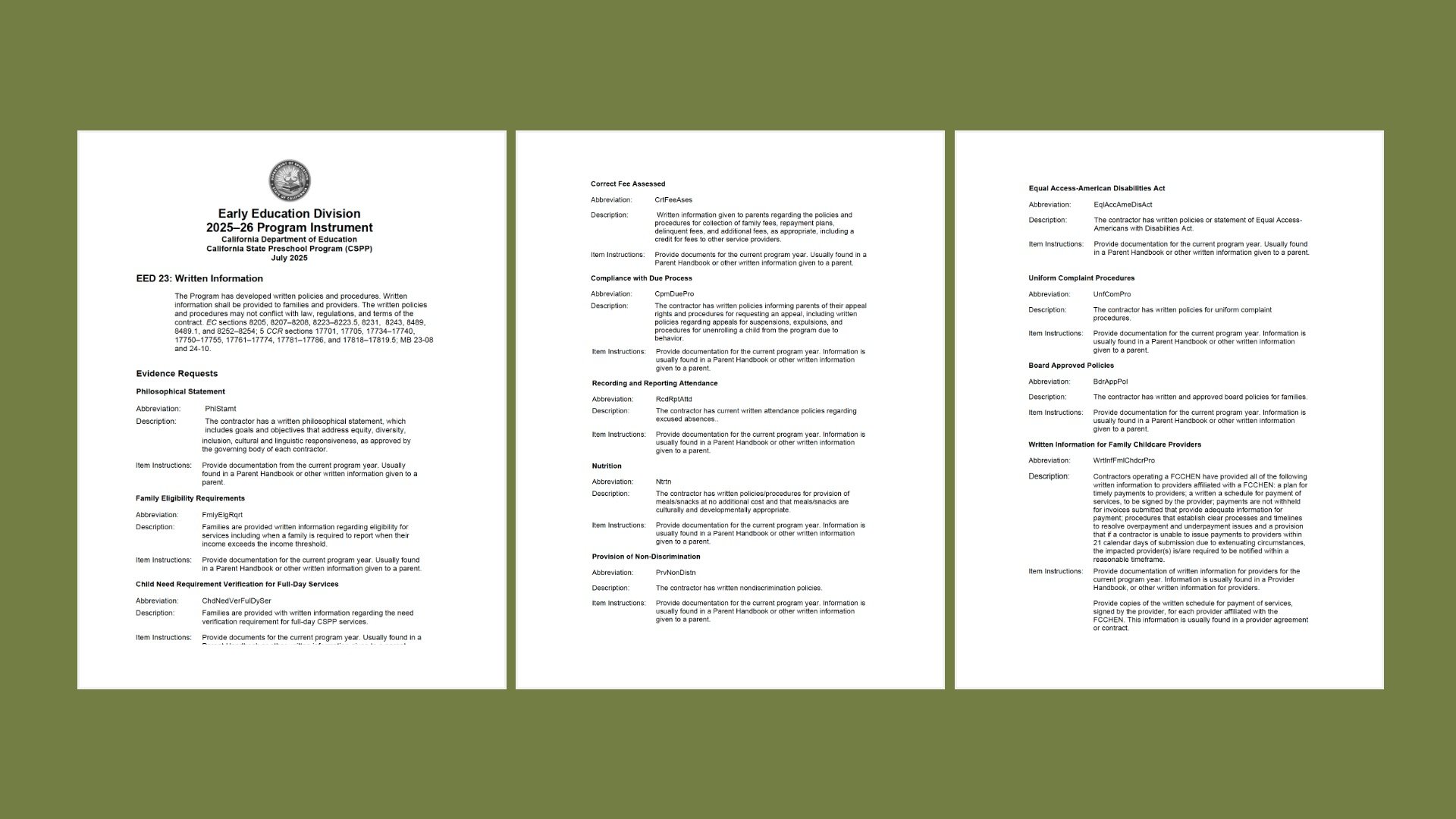Lesson
Dashboard
Lesson 1
Family Selection
Lesson 2
Family Data File
Lesson 3
Attendance
Lesson 4
Parent Engagement & Strengthening
Lesson 5
Health & Social Services
Lesson 6
Expulsion & Suspension
Lesson 7
Community Involvement
Lesson 8
Site Licensure & License Exempt
Lesson 9
Staff-Child Ratios
Lesson 10
Classroom Assessment System
Lesson 11
Nutritional Needs
Lesson 12
Desired Results Profile & Data
Lesson 13
Parent Survey
Lesson 14
Staff Qualifications
Lesson 15
Staff Development Program
Lesson 16
Refrain from Religious Instruction
Lesson 17
Inventory Records
Lesson 18
Program Self-Evaluation
Lesson 19
Contractor Parent Policies
Compliance
Indicator
The Program has developed written policies and procedures. Written information shall be provided to families and providers. The written policies and procedures may not conflict with law, regulations, and terms of the contract
Regulations/Reference
EED Program Instrument: IV. Administrative EED 23 Written Information
Education Code: 8205, 8207–8208, 8223–8223.5, 8231, 8243, 8489, 8489.1, and 8252–8254
Title 5: 17701, 17705, 17734–17740, 17750–17755, 17761–17774, 17781–17786, and 17818–17819.5
Management Bulletins: 23-08 and 24-10
Monitoring Review Evidence
Written Information for Families and/or Providers, as applicable
Evidence may be:
Participant Handbook
Postings
Webpages
Other written materials
Watch Video Lesson ❯
Sample Forms/Tools ❯
Review Sketch Pad Notes ❯
Written Information
A family or participant handbook is commonly used to place a compilation of all required written program policies. To start, you’ll want to ensure your handbook has the minimum required policies. Compare your current parent handbook table of contents with the EED Program Instrument.
NOTE: Within EED 23 Written Information, contractors will find a list of the minimum written policies required for families.
Family Written Materials
Philosophical Statement
Beyond the philosophy statement, program goals and objectives are reflected within each of the quality program components that address equity, diversity, inclusion, cultural and linguistic responsiveness:
Family Engagement & Strengthening
Health & Social Services
Education Program
Environment
Nutrition Services
Community Involvement
Staff Qualifications & Development
Program Self-Evaluation
General Policies
A center-based program parent handbook will also include many different general policies that not only cover the required Title 5 policies, but the Title 22 licensing requirements too.
Program Design
Written materials should include the Open Door Policy, along with your Refrain from Religious Instruction, Confidentiality and Equal Access/Non-Discrimination statements.
Admission Priorities
Include the process for how a family is selected for enrollment such as the program’s admission priorities.
Participation Qualifications
Include the program participation qualifications and review what items must be maintained in the family data file, such as:
Proof of residency
Family Language Survey
Court Order
Child Exceptional Needs
Proof of Family Size
Health & Emergency Information
Eligibility Criteria
Attendance | Absence Policy
Your written materials for attendance must Include your attendance policies regarding excused absences, including family emergencies, and days of absence in the best interest of the child and abandonment of care.
Disenrollment Policy
Include the process if a family voluntarily wants to disenroll, along with the agency disenrollment policy.
Grievance| Complaint
The regulations state that contractors are required to provide parents with written policy and procedures for the various types of grievance or complaints.
What this might look like in a program:
An agency might include written grievance procedures within the participant handbook.
Information may also be provided through a parent orientation video or Powerpoint that takes new enrollees through the polices & procedures to participate.
Complete Knowledge Check ❯
After reviewing the video lesson & sketch pad notes, it’s time to check for understanding by completing a Knowledge Check. Note that Individual Knowledge Checks will conclude with a Certificate.












